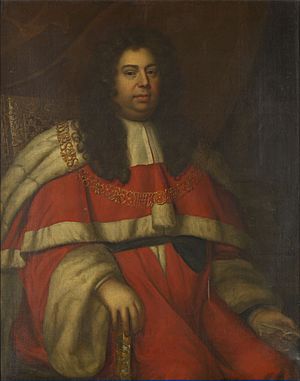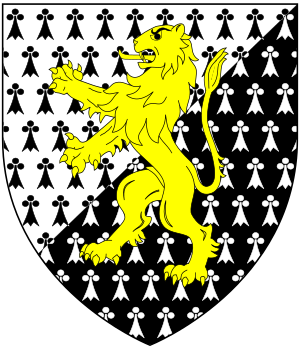Thomas Trevor, 1st Baron Trevor facts for kids
Quick facts for kids
The Lord Trevor
|
|
|---|---|

Chief Justice Trevor
|
|
| Lord President of the Council | |
| In office 8 May – 19 June 1730 |
|
| Monarch | George II |
| Prime Minister | Sir Robert Walpole |
| Preceded by | The Duke of Devonshire |
| Succeeded by | The Earl of Wilmington |
Thomas Trevor, 1st Baron Trevor (born March 8, 1658, died June 19, 1730) was an important British judge and politician. He held several high-ranking jobs in the government, including being the Attorney-General and later the Lord Privy Seal.
Contents
Thomas Trevor's Early Life and Education
Thomas Trevor was the second son of Sir John Trevor III. He studied at home before going to Inner Temple in 1672. This was a place where people trained to become lawyers. He also studied at Christ Church, Oxford, a famous university. In 1680, he officially became a lawyer, which is called being "called to the bar".
Rising Through the Legal Ranks
Trevor quickly moved up in his career. In 1683, he became a King's Counsel. This meant he was a special lawyer who advised the King. He was made a knight in 1692, which is an honor given by the King or Queen. That same year, he became the Solicitor General. This job involves helping the government with legal matters.
Just three years later, in 1695, he was promoted to Attorney-General. This is the main legal advisor to the government. In 1701, Trevor became the Chief Justice of the Common Pleas. This was a very important judge position. He was also a Privy Councillor from 1702 to 1714. This meant he was part of a special group that advised the King.
Becoming a Peer and Political Changes
In 1710, Thomas Trevor was given another important role. He became the First Commissioner of the Great Seal. This seal was used to make official government documents valid.
In 1712, he was made a peer. This meant he became a noble and was given the title of Baron Trevor of Bromham. He was one of "Harley's Dozen". This was a group of twelve new peers created to change the balance of power in the House of Lords. The goal was to help the Tories, a political party, get more votes. This was done to help secure the Peace of Utrecht, which was a peace treaty.
When King George I came to power in 1714, Trevor lost his jobs. This was because some people thought he supported the Jacobites. The Jacobites wanted to bring back the old royal family. However, in 1726, he was back in favor. He became Lord Privy Seal, another high government position, and held it until he died. He also served as one of the Lords Justice Regents of the Realm in 1727. In 1730, he became the Lord President of the Council. This was a very senior role in the government. He was also made Governor of the Charterhouse.
In 1707, he was chosen as a fellow of the Royal Society. This is a famous group that promotes science.
Thomas Trevor's Family Life
Thomas Trevor was married twice and had several children.
First Marriage and Children
In 1690, he married Elizabeth Searle. They had four children together:
- Thomas Trevor (1691-1753), who became the 2nd Baron Trevor. His daughter, Elizabeth, married Charles Spencer, 3rd Duke of Marlborough. This means she was an ancestor of future Dukes of Marlborough and even Winston Churchill!
- Elizabeth Trevor (1693-1773), who never married.
- John Trevor (1695-1764), who became the 3rd Baron Trevor.
- Laetitia Trevor (1697-1769), who married Peter Cock.
Second Marriage and Children
In 1704, he married Anne Barnard. Anne had been married before and had six children from her first marriage. With Anne, Thomas Trevor had two more children who grew up:
- Robert Trevor (1705-1783), who later became the 4th Baron Trevor and then the 1st Viscount Hampden.
- Richard Trevor (1707–1771), who became an important bishop. He was bishop of St Davids and later bishop of Durham.


